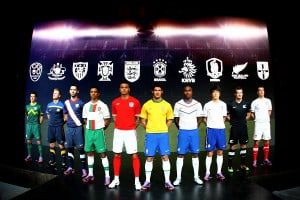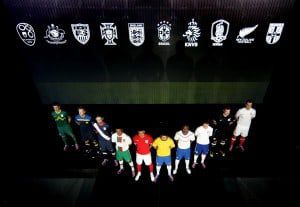Merchandising for football clubs (soccer for the Americans) is massive business. The various brands pump much development into securing sponsorship deals with the football clubs that are spread across the globe. Premier League, Serie A and La Liga clubs are now global brands and push out thousands of football tops throughout the world. Take one of the big teams globally and you’ll find that people, like me, will have home and away kits, as well as alternatives, tracksuits tops, etc.
We are in a World Cup year and have just come out of the Africa Cup of Nations so national kits are also in high demand, and I suspect the kit sponsors are going to start making a killing very soon. I know I need to get a couple. I wear the jerseys because I love to support my teams, plus they are perfect for the unfashionable, such as me, because of the hype around football in South Africa.

The style and designs have changed over the years to keep up with the times. Their development in terms of fabric has also grown in leaps and bounds taking into consideration the need for certain unique comforts for football players (read: sweating all over). This year is no different and, when the World Cup kicks off this June in South Africa, Brazil, The Netherlands, Portugal, USA, South Korea, Australia, New Zealand, Serbia, and Slovenia will all be running out to play in kits that have plastic as their primary material.
Each jersey is being created with recycled polyester created from up to eight recycled plastic bottles sourced from Japanese and Taiwanese landfill sites, melted down to produce new yam which is converted to the polyester.

According to Nike, “this process saves raw materials and reduces energy consumption by up to 30 percent compared to manufacturing virgin polyester. By using recycled polyester for its new range of national jerseys, Nike prevented nearly 13 million plastic bottles, totalling nearly 254,000 kg of polyester waste, from going into landfill sites. This amount would be enough to cover more than 29 football pitches. If the recycled bottles used to make the jerseys were laid end-to-end they would cover more than 3,000 kilometres, which is more than the entire coastline of South Africa.”

They’ve also improved on their Nike Dri-Fit fabric that is lighter than previous fabrications, with ventilation zones and increased air flow. “Ventilation zones have been placed on each side of the jersey to enhance breathability, and are combined with a fabric that increases air flow by up to seven percent compared to previous kits. These ventilation zones consist of up to 200 tiny laser cut holes which are backed by Nike’s innovative halo application. This treatment prevents ripping without reducing air flow.”
The national team home kits will be available in South Africa from May 1st in stores and online. Away kits should already be available.

